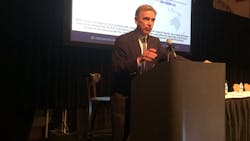Stifels’ Larkin: Driver shortage is - and will stay - trucking’s top challenge
Financial analyst John Larkin, managing director & head of Transportation Capital Markets Research for Stifel, puts the driver shortage square at the top of his list of the “the ten largest factors likely to shape transportation and logistics in the future.” And he contends the shortage will only be “magnified” over time.
Larkin pointed out that the issue that most dogs trucking now and will continue to do so is partially the result of major societal shifts.
“There is a driver shortage in the U.S. in part because the blue collar workforce is shrinking rapidly and because our society has moved from a focus on goods and products to services,” he explained in keynoting the annual FTR Transportation Conference.
Citing FTR and Stifel research, Larkin stated that “forward-looking projections show a gap in the growth of driver supply and demand, validating the concern over the shortage.”
What’s more, he argued that “efforts to counterbalance a driver shortage need to look at increasing the driver pool to keep up with growing demand-- not simply preventing it from shrinking.”
Then, noting that “with fewer Americans considering blue collar options” even as “automated production, near shoring and insourcing will only increase the amount of domestic freight to be moved,” he asked rhetorically “where will our truck drivers come from and “are there any potential solutions to the worsening driver shortage that haven’t already been tried?”
Replying to his own query, Larkin said that the shortage is the result of a “collection of impacts from multiple factors, rendering a solution more challenging to identify.”
Along with the demographic/societal movement away from “blue collar options,” he explained that the driver pool is also shrinking because of the negative impact of safety regulations on drivers as well as the general difficulties they encounter regarding life on the road.
Taking to task a potential remedy-- which seems to be gaining traction with some major fleets— he contended that simply increasing pay to attract and retain drivers is not enough.
“Higher pay won’t be the full answer,” said Larkin. “Those fleets paying drivers $80,000 a year are having a much trouble finding them as others are.
“Unfortunately, it isn’t quite that simple” to meet the challenge with pay hikes alone, he stressed. “The average life expectancy of a trucker is 61 while that of the general public is 77. So, increasing pay may help the supply some, but it is not a solution to the true problem.”
Reinforcing his take on what’s happening with driver pool, Larkin listed the “Demographics of Modern America” as the next largest factor challenging trucking/logistics.
“The size of the American workforce has been on a steady decline over the last decade,” he continued, “requiring each individual to be more productive to sustain a growing population and economy.”
He explained that “the American population is aging rapidly, and fertility is [now] and is projected to be at near term lows. An aging population is a direct result of declining fertility rates and improved healthcare. This is resulting in a very high portion of elders in society. And with younger generations growing at a much slower rate than elders, the working age proportion is shrinking.
“The size of the core workforce [ages 21-50] is a declining portion of the population,” Larkin pointed out, citing Bureau of Labor Statistics and Census data. While that group accounted for 41% of the workforce in 2000, it now stands at 38% and falling.
Meanwhile, the “younger generations [those under 21] are not large enough to backfill the aging population,” he continued. That group accounted for 31% of the workforce in 2000— but only 30% now. As for those 50 and over, they accounted for 27% in 2000 and 33% now.
Making matters worse for trucking and other industries that rely on blue-collar labor, Larkin pointed out that “of the declining number of people working, less and less of them are moving into traditional blue-collar careers” while all Americans are becoming larger consumers of goods and services.
“The white collar workforce has increased from 25% of employment in 1920 to over 70% in 2010,” he explained, “but each individual is consuming more and more tons of freight.”
Rounding out Larkin’s top three challenges is the economy’s ongoing shift away from producing goods to providing services.
“During the last half century our level of education has positioned us away from goods production and into services,” he said. “An increasing number and tonnage of goods are now being produced domestically despite fewer people working in production, which is a testament to our engineering ability.”
Larkin noted that, as a percent of GDP, services have increased “from just under 50% in 1950 to 68.7% in 2010, while over the same period of time goods producers have been halved.”
Despite fewer production jobs now being available and going forward, he said that “transportation and logistics demand will grow, thanks to automation, 3-D printing, near-shoring” and other such trends in modern commerce.
What’s more, Larkin advised that “as the service industry grows, so will its offering of jobs-- driving people toward [working and living in] metro areas.”
Here, in ascending order of importance, are the other seven largest factors likely to shape transportation and logistics in the future that Larkin listed:
- De-globalization of production
- Urbanization and migration in America
- E-commerce and omni-channel fulfillment
- Continuous optimization to maximize efficiency
- Domestic “energy revolution,” particularly in CNG and LNG
- Regulatory onslaught
- Lack of robust infrastructure investment
